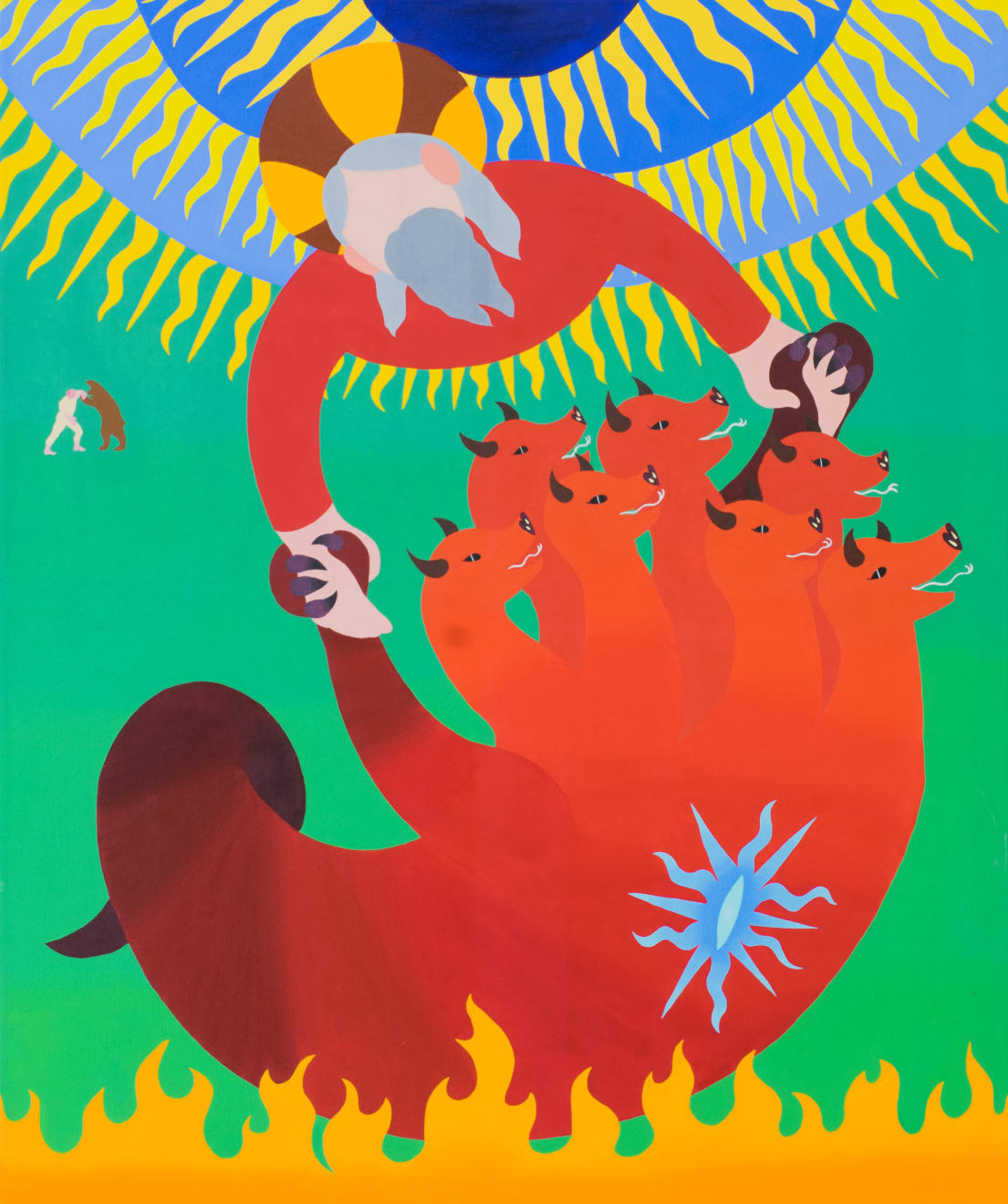Monika Radžiūnaitė Lithuanian, b. 1992
The two poles are hooked together, one cannot without the other / Polis duobus continentur, sine altero non, 2020
Aliejus ant drobės / Oil on canvas
120 x 100 x 2.5 cm
Monika Radžiūnaitė's work, 'The two poles are hooked together, one cannot without the other / Polis duobus continentur, sine altero non,' belongs to her 'Circumstances' series. When considering colours in...
Monika Radžiūnaitė's work, "The two poles are hooked together, one cannot without the other / Polis duobus continentur, sine altero non," belongs to her "Circumstances" series.
When considering colours in the Middle Ages, one must mentally grasp the meanings of colours, which functioned as distinguishing marks and symbols in characters, objects, backgrounds, or details. Red and blue are contrasted as opposing poles, echoing the work's title. Blue in the Middle Ages was the colour of divinity, truth, and faithfulness, symbolising the heavens and all that is associated with them. Red, though its meaning often depended on context, signifies blood and fire, life and the passion of love – things not found in heaven.
However, both poles depicted in the work feature a small colour detail that mirrors their counterpart. The figure of God is clothed in red, while the biblical character – the seven-headed beast – opposed to the one above it, is depicted in red with dark brown and black elements – a common medieval palette for hell. The negative aspect of Christian red was almost always associated with bloodshed and the flames of hell.
Medievalist Michel Pastoureau even wrote that "[a]fter death, sinners go to hell, a terrible place in the depths of the earth, absolutely red and black – if we are to believe the paintings that, after the year 1000, increasingly depicted it that way as the theme of the Last Judgment became more widespread. Black is the colour of the darkness that reigns there eternally, and red is the 'lake of fire' (Revelation 22:10-15), the second death. [...] Although in miniatures hell is sometimes colourful, red and black still predominate."
The green colour filling the background of the work refers to divine creation, where humanity lives, left to contend with dangers. There is neither blue nor red in the green that could serve as a symbolic refuge for humanity, left to the whims of fate and at the edge of the canvas.
When considering colours in the Middle Ages, one must mentally grasp the meanings of colours, which functioned as distinguishing marks and symbols in characters, objects, backgrounds, or details. Red and blue are contrasted as opposing poles, echoing the work's title. Blue in the Middle Ages was the colour of divinity, truth, and faithfulness, symbolising the heavens and all that is associated with them. Red, though its meaning often depended on context, signifies blood and fire, life and the passion of love – things not found in heaven.
However, both poles depicted in the work feature a small colour detail that mirrors their counterpart. The figure of God is clothed in red, while the biblical character – the seven-headed beast – opposed to the one above it, is depicted in red with dark brown and black elements – a common medieval palette for hell. The negative aspect of Christian red was almost always associated with bloodshed and the flames of hell.
Medievalist Michel Pastoureau even wrote that "[a]fter death, sinners go to hell, a terrible place in the depths of the earth, absolutely red and black – if we are to believe the paintings that, after the year 1000, increasingly depicted it that way as the theme of the Last Judgment became more widespread. Black is the colour of the darkness that reigns there eternally, and red is the 'lake of fire' (Revelation 22:10-15), the second death. [...] Although in miniatures hell is sometimes colourful, red and black still predominate."
The green colour filling the background of the work refers to divine creation, where humanity lives, left to contend with dangers. There is neither blue nor red in the green that could serve as a symbolic refuge for humanity, left to the whims of fate and at the edge of the canvas.
Exhibitions
2021 - Superfluitates, Pamėnkalnio galerija, VilniusLiterature
BOOKS/CATALOGUES2021 – Superfluitates, interactive catalogue, www.hyperlink.lt, ed.: Linas Bliškevičius, 2021



